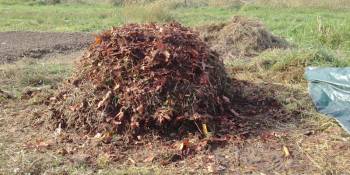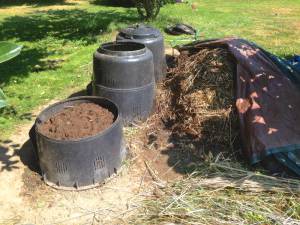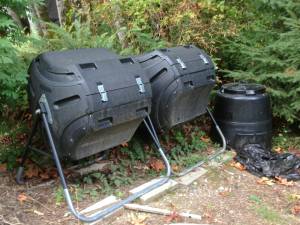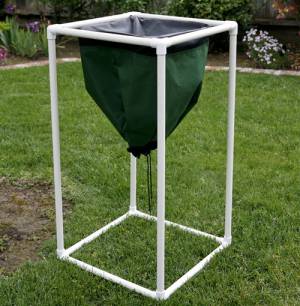Table of Contents
Compost bins
I put my “junk” compost in piles and cover it with a tarp. But for my quality compost I prefer the bin that sits on the ground. I do also use two rotating, tumbler bins.
Junk pile
 Layers of weeds, corn stalks and corn husks make up this pile. To be covered with a tarp and allowed to cook. The only forest products (wood) that I allow are leaves, preferably those that decompose quickly. Regarding leaves, the maple leaves I have are not ideal - they take 20-24 months to decompose and they must be mixed in, preferably chopped up, or else they create matted barriers to decomposition.
Layers of weeds, corn stalks and corn husks make up this pile. To be covered with a tarp and allowed to cook. The only forest products (wood) that I allow are leaves, preferably those that decompose quickly. Regarding leaves, the maple leaves I have are not ideal - they take 20-24 months to decompose and they must be mixed in, preferably chopped up, or else they create matted barriers to decomposition.
Earth Machine
 There are my favorite because they work. One advantage I didn't anticipate is that worms come up from the ground and finish off the composting process. The horizontal slats on each side of the bin allow air to circulate through the compost, the top half snaps off to allow regular turning of the compost, and a bottom door lifts up for access to completed compost.
There are my favorite because they work. One advantage I didn't anticipate is that worms come up from the ground and finish off the composting process. The horizontal slats on each side of the bin allow air to circulate through the compost, the top half snaps off to allow regular turning of the compost, and a bottom door lifts up for access to completed compost.
Tumbler bin
 The idea seems great - these should make it easy to turn the compost via the rotating “tumbler.” The practice isn't so great. The tumbling motion tends to ball up the compost. Also, there isn't enough ventilation to keep the compost at a proper moisture content. Mine are always too wet and it's hard to adjust that.
The idea seems great - these should make it easy to turn the compost via the rotating “tumbler.” The practice isn't so great. The tumbling motion tends to ball up the compost. Also, there isn't enough ventilation to keep the compost at a proper moisture content. Mine are always too wet and it's hard to adjust that.
And while they appear to have a larger capacity, in reality, loading one past half full makes for to big a load and makes it almost impossible to tumble. This is a nice idea that just doesn't make it in the real world.
Vermicomposting
 One way of making compost is to let someone else do it - with your own materials, as in vermicomposting, or composting by worms in a special enclosure.
One way of making compost is to let someone else do it - with your own materials, as in vermicomposting, or composting by worms in a special enclosure.
The Worm Inn
I have a “flow-through” worm bin like the one pictured here from Red Worms Work. See the informative Worm In brochure for details.
I save kitchen scraps in a jar and about once a week I dump the contents into the worm bin. I'm choosey about what goes into the compost jar. I only include items that decompose quickly:
- ONLY vegetable scraps, a few tea bags and some coffee grounds
- NO animal fat or protein
- NO citrus skins
- NO avocado skins or seeds
- NO corn cobs
- NO fruit pits
I regularly add finely crushed eggshells to help the worms with their digestion. And to keep the worms happy I add bedding from time to time - damp paper crumpled up and set off to one side.
First-rate fertilizer
I harvest the worm castings every four to six months. The worms don't generate a lot of humus, but what does come from it is first-rate.
That's just to say the worm castings gave the tomatoes an extra boost. I wish I could make more - but then I'd have to eat more (not good 
